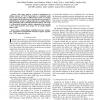Free Online Productivity Tools
i2Speak
i2Symbol
i2OCR
iTex2Img
iWeb2Print
iWeb2Shot
i2Type
iPdf2Split
iPdf2Merge
i2Bopomofo
i2Arabic
i2Style
i2Image
i2PDF
iLatex2Rtf
Sci2ools
CAL
2008
2008
Hierarchical Instruction Register Organization
This paper analyzes a range of architectures for efficient delivery of VLIW instructions for embedded media kernels. The analysis takes an efficient Filter Cache as a baseline and examines the benefits from 1) removing the tag overhead, 2) distributing the storage, 3) adding indirection, 4) adding efficient NOP generation, and 5) sharing instruction memory. The result is a hierarchical instruction register organization that provides a 56% energy and 40% area savings over an already efficient Filter Cache.
| Added | 09 Dec 2010 |
| Updated | 09 Dec 2010 |
| Type | Journal |
| Year | 2008 |
| Where | CAL |
| Authors | David Black-Schaffer, James D. Balfour, William J. Dally, Vishal Parikh, JongSoo Park |
Comments (0)

